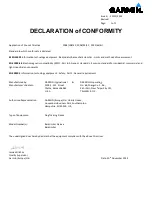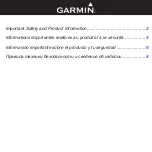
26
Sitter Elite
Steps to Apply Over Mattress Sensor
See pages 22-24 for list of warnings.
1. Select the correct sensor for your patient:
• Disposable 30-Day Sensors. For short-term use.
• 6-Month Sensors. For long-term use.
2. Check that sensor pad, cord and plug are clean and
undamaged.
3. Choose a position for sensor pad (fig. 36):
(A) Centered at patient’s shoulder blades; or
(B) Centered under patient’s buttocks.
4. Place non-slip Posey Grip on mattress at area
chosen for sensor. Place sensor pad over Posey
Grip, across width of bed.
5. Use metal clips to secure sensor to mattress.
6. Place bottom sheet over sensor.
7. If needed, use an incontinence pad to protect sensor from urine
or other liquids. Sensor may fail if liquid enters at “neck” of
sensor pad.
8. Route the sensor cord to the alarm. Check that the sensor cord is
not stressed, is clear of moving parts of bed, and does not pose a
tripping hazard.
9. Insert RJ11 plug into jack labeled “sensor” on right side of alarm
(fig. 37). Alarm will activate. Press the HolD button. You have
30 seconds to transfer the patient to the bed before monitoring
begins (see instructions on page 15 for use of the HolD button).
10. Test sensor and alarm (see below)
11. Position patient in bed, with weight centered on sensor pad.
Fig. 36
Sensor At
Shoulder
Position
Sensor
Under
Buttocks
Mattress
Bed Frame
A
B
Testing Alarm and Sensors
ALWAYS
check sensor pads when connecting them to a Posey
alarm. You can check a pad by attaching it to the sensor cable
outlet in the alarm, activating the alarm and placing pressure on the
pad (fig. 38). When the pressure is released, the alarm should sound.
Repeat this pressure/release test in several different areas along the
entire length of the sensor to ensure entire pad functions properly
both with the bed in the flat position and the head and/or foot
articulated. If the alarm and/or sensor do not function properly,
remove the alarm and sensor from service and replace them with a properly functioning alarm
and/or sensor. Do NoT use the alarm or sensor if it does not activate each time weight is
removed from the sensor.
Storing Pad Sensors when not in use
ALWAYS
store pad sensors flat in a dry secure environment. Do NoT roll, bend or fold over
mattress pad sensors. This may cause them to malfunction. You can also store the sensors
by hanging from the hole on the side of the sensor pad. Ensure sensor cords remain bundled
together in the sensor packaging. DO NOT stretch or place pressure on the cords, as this could
cause a malfunction in the sensor pad.
Fig. 37
NURSE
CALL
SENSOR
9V
Fig. 38
TESTING OVER
MATTRESS SENSOR PAD















































